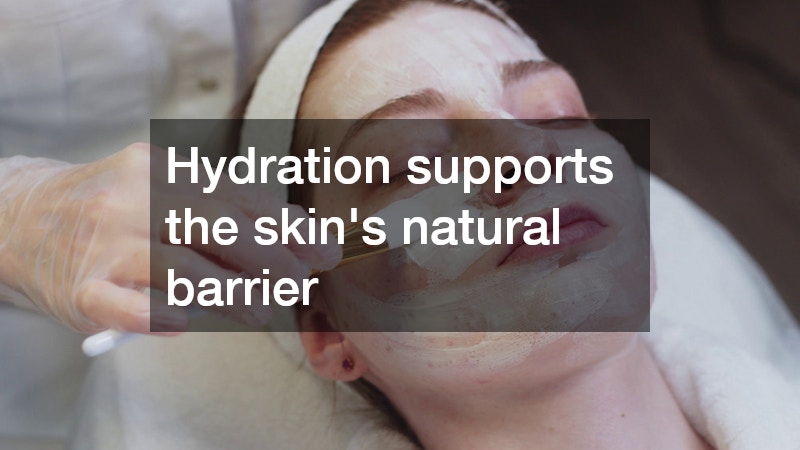Disclaimer: The Purple Feather. This site provides fashion and lifestyle content for informational purposes only.
Here are the key takeaways from the article:
-
Combining consistent at-home skincare with professional med spa for facial and cosmetic treatments delivers the best, long-lasting results.
-
Understanding your unique skin type and concerns is essential for choosing the right products and treatments.
-
Daily routines should focus on cleansing, moisturizing, sun protection, and gentle exfoliation tailored to your skin.
-
Professional treatments provide deeper, targeted care that enhances and accelerates improvements beyond what home care can achieve.
-
Safely coordinating your home routine with professional procedures helps prevent irritation and maximizes benefits.
-
Lifestyle factors like hydration, diet, sleep, and stress management play a critical role in overall skin health.
-
Regular consultations and personalized plans ensure your skincare evolves with your skin’s changing needs.

Healthy, glowing skin doesn’t happen by chance. It’s the result of a carefully crafted routine that combines daily care with professional expertise. While many people rely solely on their at-home skincare products or occasionally visit a med spa for facial and cosmetic treatments, the most effective results come from blending both approaches. At-home routines are essential for maintaining cleanliness, hydration, and protection, but they have limitations when it comes to addressing deeper skin concerns. Professional treatments, on the other hand, use advanced technologies and specialized procedures that work beneath the surface, targeting stubborn pigmentation, fine lines, and uneven texture. This article will explore how to safely and effectively combine your everyday skincare regimen with expert med spa services to maximize results and keep your skin radiant and healthy.
Understanding Your Skin and Its Needs
Before embarking on any new skincare regimen or treatment plan, it’s crucial to understand your skin’s unique characteristics and concerns. Everyone’s skin is different, shaped by factors such as genetics, environment, lifestyle, and age. Knowing your skin type — whether dry, oily, combination, or sensitive — will help you select products and treatments that nourish rather than irritate. For example, dry skin benefits from rich moisturizers and gentle cleansers, while oily skin requires lightweight, oil-free formulations that control shine without clogging pores.
Aside from type, specific concerns like acne, hyperpigmentation, fine lines, and dullness often evolve over time and require targeted care. Aging skin tends to lose elasticity and moisture, making collagen-stimulating treatments at a med spa for facial and cosmetic treatments valuable. Acne-prone skin, meanwhile, may require regular exfoliation and anti-inflammatory treatments to prevent breakouts. Many med spas offer personalized skin consultations, which include comprehensive skin analysis to detect issues that aren’t always visible to the naked eye. This assessment allows professionals to tailor both in-clinic treatments and at-home care to your skin’s exact needs, making your routine safer and more effective.
The Role of At-Home Skincare in Daily Maintenance
Your daily skincare routine is the cornerstone of healthy skin. Professional treatments can provide noticeable improvements, but consistent maintenance through cleansing, moisturizing, and protecting your skin daily is what sustains those benefits over time. At home, your goal is to keep the skin barrier intact, provide necessary hydration, and shield the skin from environmental aggressors like pollution and UV rays.
Essential at-home skincare steps include:
-
Cleansing: Removing makeup, dirt, and excess oil is fundamental. A well-chosen cleanser suited for your skin type prevents irritation or dryness. Many experts recommend double cleansing—starting with an oil-based cleanser to dissolve makeup and sunscreen, followed by a gentle water-based cleanser to clear residual impurities.
-
Moisturizing: Hydration supports the skin’s natural barrier and prevents moisture loss. Ingredients like ceramides, glycerin, and hyaluronic acid lock in moisture without clogging pores. Oily skin types benefit from gel-based or oil-free moisturizers, while dry skin types require richer creams.
-
Sun Protection: Daily use of a broad-spectrum sunscreen with at least SPF 30 is the most crucial step to prevent premature aging and skin cancer. Even on cloudy days or when indoors, UV exposure can affect your skin, making sunscreen a non-negotiable.
-
Exfoliation: Removing dead skin cells encourages cell turnover, revealing fresher, smoother skin. Chemical exfoliants such as alpha hydroxy acids (glycolic, lactic acid) and beta hydroxy acids (salicylic acid) gently break down the bonds holding dead cells. Physical exfoliation with scrubs should be used cautiously to avoid microtears.

Key active ingredients to look for in your products:
-
Hyaluronic Acid: A moisture magnet that can hold up to 1000 times its weight in water, helping plump and hydrate skin.
-
Retinol: A derivative of vitamin A that speeds up cell renewal and stimulates collagen production, improving wrinkles and uneven texture.
-
Vitamin C: An antioxidant that brightens skin tone and neutralizes environmental damage.
-
Niacinamide: Soothes inflammation, reduces redness, and helps regulate oil production.
-
Peptides: Support skin repair and firmness.
Tips for maximizing at-home skincare effectiveness:
-
Establish a morning routine focused on cleansing, moisturizing, antioxidant application, and sunscreen.
-
Develop an evening routine that includes makeup removal, cleansing, and applying reparative ingredients such as retinol or peptides.
-
Apply products in order from thinnest to thickest to enhance absorption and efficacy.
-
Avoid mixing conflicting actives like retinol and vitamin C simultaneously to minimize irritation.
-
Be consistent and patient—skin renewal cycles take approximately 28 days, so benefits accumulate over time.
Professional Treatments at a Med Spa for Facial and Cosmetic Treatments
Professional skincare treatments performed at a med spa offer targeted solutions to skin concerns that cannot be fully addressed by at-home products. These treatments utilize cutting-edge technologies and stronger formulations that penetrate deeper layers of the skin, promoting rejuvenation and repair.
Popular professional treatments include:
-
Chemical Peels: These treatments use various acid solutions to exfoliate dead skin cells and stimulate cell turnover. From superficial to deep peels, they address acne scars, uneven tone, and fine lines.
-
Laser Therapies: Fractional lasers, IPL (intense pulsed light), and other laser treatments correct pigmentation irregularities, reduce redness, and stimulate collagen.
-
Microneedling: This procedure creates tiny controlled injuries that trigger the skin’s healing response, boosting collagen and elastin production for smoother, firmer skin. It can be combined with serums or platelet-rich plasma (PRP) to enhance effects.
-
Microdermabrasion: A mechanical exfoliation that removes surface dead skin cells, improving texture and allowing better absorption of skincare products.
-
Hydrafacials: Multi-step treatments combining cleansing, exfoliation, extraction, hydration, and antioxidant infusion to deeply nourish skin.
Why professional treatments are valuable:
-
They offer higher concentrations of active ingredients safely applied under expert supervision.
-
They provide customized care based on detailed skin analysis and your unique concerns.
-
They allow access to advanced technologies and techniques unavailable for home use.
-
They deliver accelerated and longer-lasting results when combined with daily maintenance.
Safety and aftercare considerations:
-
Many treatments cause temporary redness, peeling, or sensitivity, requiring appropriate soothing and protection afterward.
-
Post-treatment, your provider will recommend gentle cleansers, moisturizers, and strict sun protection to support healing.
-
Proper spacing between treatments and avoiding certain active ingredients before and after sessions are critical to prevent irritation.
How to Safely Combine At-Home Skincare with Professional Treatments
To achieve the best results, at-home skincare and professional treatments should be coordinated carefully to avoid over-exfoliation, irritation, or sensitization.
Guidelines for combining care:
-
Adjust your routine before treatments: Avoid retinol, strong exfoliants, and acids at least 3-5 days before receiving chemical peels, microneedling, or laser sessions. This minimizes sensitivity and reduces the risk of adverse reactions.
-
Modify your products after treatment: Use gentle, hydrating, and barrier-repairing products containing ingredients like ceramides, aloe vera, and squalane for 1-2 weeks following procedures. Avoid active exfoliants and harsh cleansers.
-
Maintain diligent sun protection: After treatments, your skin will be more sensitive to UV rays, making daily SPF application critical to prevent damage and pigmentation.
-
Space treatments appropriately: Don’t schedule multiple aggressive treatments too close together; allow your skin time to heal and respond.
-
Monitor your skin’s reaction: Pay attention to any prolonged redness, peeling, or discomfort and consult your med spa provider if you notice unusual responses.
Practical tips for home care during professional treatment cycles:
-
Incorporate antioxidant-rich serums to protect against free radicals and enhance skin repair.
-
Hydrate your skin with moisturizers that support barrier function.
-
Use calming products that reduce inflammation and redness.
-
Avoid heavy makeup or pore-clogging products during recovery phases.

Creating a Personalized Skincare Plan
A personalized skincare plan that integrates both med spa treatments and at-home care is essential to address your specific concerns and maximize benefits.
Steps to develop your plan:
-
Get a thorough skin assessment at a med spa for facial and cosmetic treatments. Professionals will analyze your skin’s texture, hydration, pigmentation, and elasticity.
-
Define your goals, whether to reduce acne, diminish wrinkles, brighten skin, or improve overall texture.
-
Select appropriate treatments based on your skin type, concerns, and lifestyle. For example, someone with acne scars might opt for chemical peels and microneedling, while those with aging skin could benefit from laser therapies and collagen-boosting facials.
-
Choose complementary at-home products that support your treatments—like retinol for anti-aging or gentle cleansers for acne-prone skin.
-
Set a realistic schedule for professional treatments (e.g., monthly or bi-monthly) and daily home routines.
-
Review and update your plan every few months, as skin needs change with age, seasons, and other factors.
Example personalized routines:
-
Anti-Aging: Monthly microneedling sessions paired with nightly retinol application and daily vitamin C serum.
-
Acne Management: Chemical peels every 6-8 weeks combined with daily salicylic acid cleanser and oil-free moisturizers.
-
Brightening: Laser treatments quarterly complemented by antioxidant-rich serums and gentle exfoliation at home.
Lifestyle Factors That Support Healthy Skin
Skincare extends beyond products and treatments; your lifestyle has a profound impact on your skin’s appearance and health. Good habits enhance your skin’s ability to respond to both at-home and professional care.
Essential lifestyle tips:
-
Hydration: Drinking sufficient water maintains skin elasticity and supports detoxification processes. Aim for 8-10 glasses daily.
-
Balanced diet: Consume foods rich in antioxidants (berries, leafy greens), omega-3 fatty acids (fish, flaxseed), and vitamins (A, C, E) to nourish your skin from within.
-
Adequate sleep: Skin repairs and regenerates during deep sleep cycles; aim for 7-9 hours per night.
-
Stress management: Chronic stress elevates inflammatory hormones that can worsen skin conditions. Techniques like meditation, yoga, and breathing exercises can help.
-
Avoid smoking and limit alcohol: Both accelerate aging and dry out the skin.
-
Regular exercise: Improves circulation, delivering nutrients and oxygen to skin cells and promoting a natural glow.
Common Myths and FAQs About Combining Skincare Treatments
Myth #1: Professional treatments replace the need for home care.
Professional treatments amplify results but cannot substitute daily skincare that maintains barrier health and protects skin long-term.
Myth #2: Natural skincare products don’t require professional advice.
Even natural ingredients can cause sensitivities or interfere with treatments, so consulting professionals is important.
FAQs:
-
How often should I get med spa treatments?
Treatment frequency depends on your skin and the procedure but typically ranges from every 4-6 weeks. -
Can I use retinol immediately after laser treatments?
It’s recommended to wait at least 5-7 days or follow your provider’s guidance to avoid irritation. -
Are professional treatments safe for sensitive skin?
Yes, when customized and performed by trained professionals who understand sensitive skin needs.
For radiant, healthy skin, the best approach combines consistent at-home skincare with professional treatments at a med spa for facial and cosmetic treatments. While your daily routine maintains hydration, protection, and basic exfoliation, professional procedures provide the targeted boost needed to address deeper concerns. By understanding your skin, working with experts, and integrating care thoughtfully, you can achieve lasting results that adapt with your changing skin needs. Skincare is a lifelong journey — blending the best of home and professional care ensures you look and feel your best every day.

